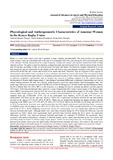Physiological and Anthropometric Characteristics of Amateur Women in the Kenya Rugby Union
Date
2020-10-16Author
Wangui, Anthony Muchiri
Wamukoya, Edwin Kadima
Olutende, Micky Oloo
Metadata
Show full item recordAbstract
Rugby is a team body contact sport that is popular in many countries internationally. The team involves two opposing
teams trying to carry an oval shaped ball to the end of a rectangular field, while preventing the other team doing the same
it has demands broadly characterized by a high frequency of physical contacts and repeated intermittent bouts of high
intensity activity. The game is played at amateur, semiprofessional, and professional levels with the players being divided
into two groups, according to their on-field positions (forwards and backs). Forwards are roughly considered to be the
ball conquerors and are responsible for the dispute of the ball both in static and dynamic moments of the game. They are
involved in all the line outs, scrums and in most of the mauls and rucks. Therefore, they are required to have a group of
characteristics that enables them to perform in these situations. Forwards are heavier than backs. The assessment of body
composition in professional rugby players is frequently performed as part of their routine monitoring procedures in order
to optimize competitive performance and to monitor the success of training regimen. For the optimal physical
development of female rugby league players’, knowledge of positional differences in physical characteristics are vital to
inform training practices the data was collected using protocols which the rugby players filled demographic data. The
multi-stage fitness test, also known as the PACER test or PACER (Progressive Aerobic Cardiovascular Endurance Run),
the 20 m Shuttle Run Test (20 m SRT), or the beep test, is a running test used to estimate an athlete's aerobic capacity
(VO2 max). Following institutional ethics approval, A team (Impala ladies Rfc) in the women league of the Kenya rugby
union (KRU) was purposively selected from the rest of the teams in the championship league for the study. Thirty (30)
women rugby league players from the team were recruited and participated in the study. A total of 30 players were
sampled mean age 22.20±3.605. 73.3% (22) of the participants were Students, 16.7% (5) and 10% (3) were in
employment. The mean for the caps was .40±.814. There was a significant correlation between the age and primary
position of the players (ꭓ
2
=14.267, df=8, P˂.0075). There was no relationship between the players position and the
acquiring of the NHIF cover (ꭓ
2
=.370, df=1, P˂.543). 178.2 (175.8 to 180.6) cm, 85.8 (80.6 to 91.0) kg, and 18.8 (17.3
to 20.3) % respectively. Forwards were significantly older (p<0.01) significantly heavier (p<0.01) than backs. estimated
V~O2MAX scores for all subjects were 38.1 (35.7 to 40.5) cm, 2.58 (2.51 to 2.65) seconds, 6.63 (6.53 to 6.73) seconds,
and 38.98 (37.18 to 40.78) ml/kg/min respectively. Scores for vertical jump were not significantly different (p>0.05)
between forwards and backs. Although backs were faster than forwards during the 10 m sprint, the difference was not
significant (p =0.07). Backs were significantly faster (p<0.01) than forwards during the 40 m sprint. No significant
differences (p>0.05) were observed between forwards and backs for estimated V~O2MAX. In conclusion, when
compared with professional players, estimates of maximal aerobic power, speed, and muscular power were lower, and
percentage body fat higher in amateur rugby league players. Values for percentage body fat, vertical jump, 10 m sprint,
and maximal aerobic power were not significantly different between forwards and backs. The results of this study show
that the physiological and anthropometric characteristics of amateur women rugby league players are poorly developed.
Keywords: Anthropometric tests, Physiological, Rugby Union, V~O2MAX, Rugby Players.
URI
https://doi.org/10.36348/jaspe.2020.v03i10.004https://saudijournals.com/media/articles/JASPE_310_193-198_BlgTo2E.pdf
http://ir-library.mmust.ac.ke:8080/xmlui/handle/123456789/2013
Collections
- Journal Articles [411]

